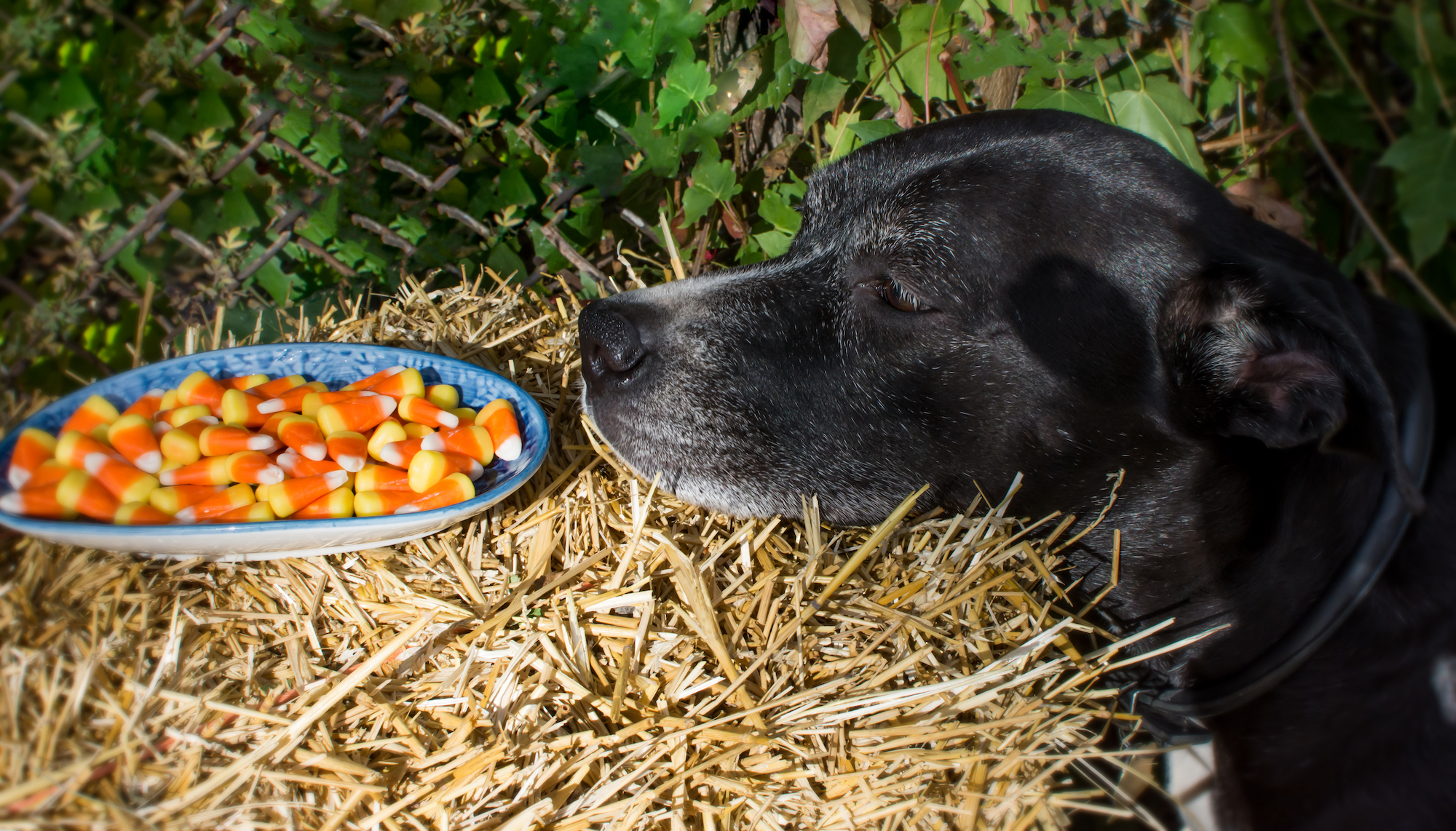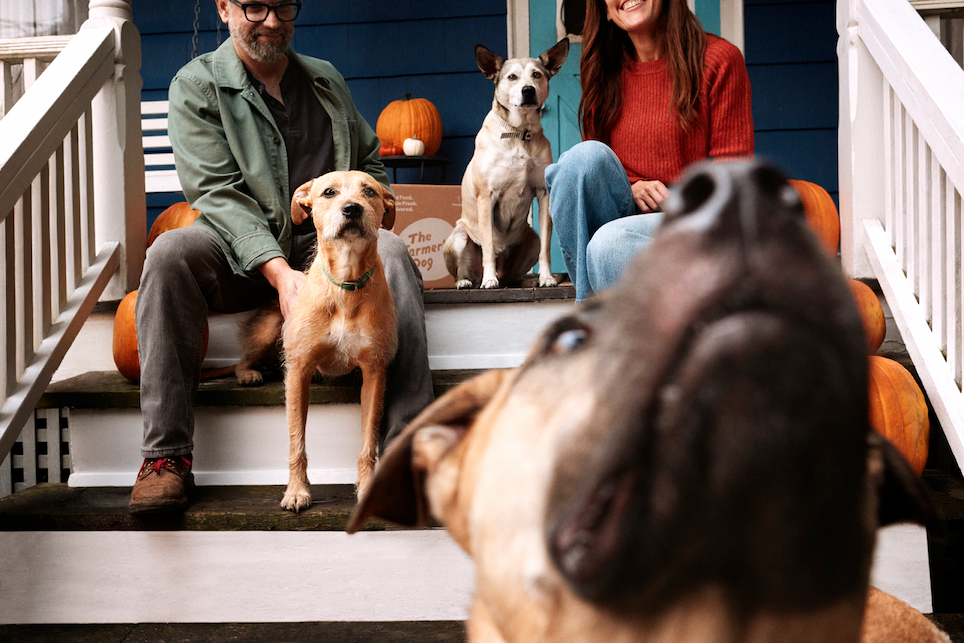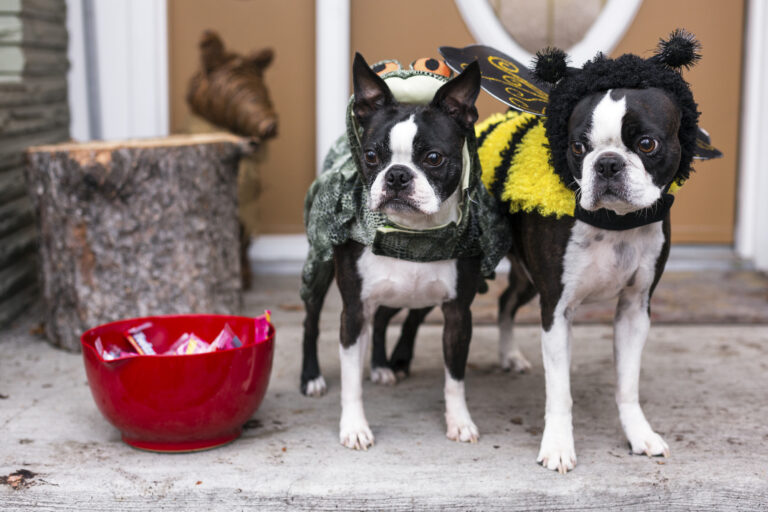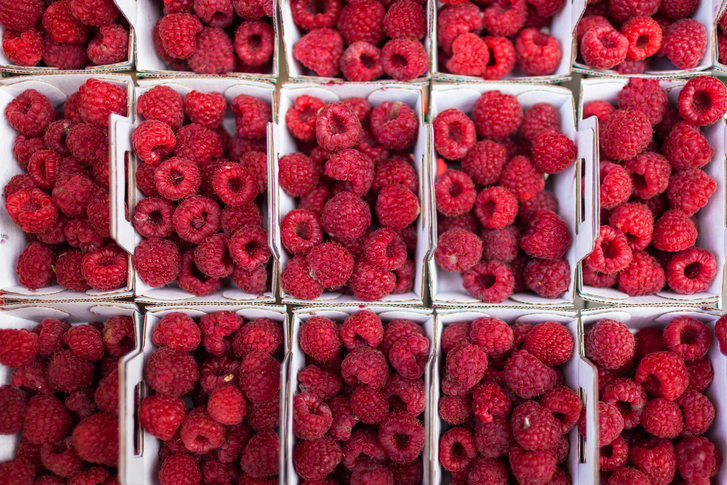
In this article:
- Why you shouldn’t give your dog Halloween candy
- Why sugary candy can be dangerous for dogs
- Which Halloween candy is most hazardous to dogs?
This article was updated in October of 2025.
Spooky season brings ghouls, goblins, ten-foot skeletons—and candy. Bowls, pillowcases, and jack-o-lanterns full of candy.
You are your own candy-control authority, but you also need to act as a treat gatekeeper for the canine members of your family. To help prevent real Halloween horror, we’ve conjured a quick guide to which seasonal treats are strictly off-limits.
Should you give your dog Halloween candy at all?
The short answer is: no. Maybe you live somewhere where they’re handing out baby carrots—but, for the most part, Halloween treats tend to be made of sugar, chocolate, and combinations thereof. Dogs can consume sugar in the form of fruit, but it’s a good idea to steer clear of processed sugar. Sugar is not toxic per se, but—as it does in humans—it can contribute to dental disease, acute pancreatitis, diabetes, obesity, and inflammation in dogs, and can also cause stomach upset. Chocolate is a strict no-no, as it’s toxic to dogs (see more below).
Here’s a breakdown of how dangerous various popular candies are for dogs.
Less dangerous, but still skip
Sugary candy
We’re talking about your colorful, sugar-forward treats like candy corn, Skittles, and Lemonheads. These treats aren’t generally toxic, but are full of sugar, corn syrup, dyes, and other things that aren’t good for a dog’s teeth, stomach, or waistline. Small, hard or chewy candies can also be a choking hazard, so resist the temptation to share the rainbow.
Chewy and gummy candies can also pose a risk to dogs. If dogs eat large quantities of these, it “can lead to fluid shifts into the stomach and intestinal tract, which can cause electrolyte imbalances,” said Dr. Renee Schmid, director of veterinary medicine and senior veterinary toxicologist for the Pet Poison Helpline. “This can cause difficulty walking (ataxia), body tremors, and seizures.”

More dangerous, strictly avoid
Chewing gum
Chewing gum is not an appropriate treat for dogs for many obvious reasons—but the most pressing reason to avoid it is that it often contains xylitol, an artificial sweetener that is extremely toxic to dogs.
“Sugar-free” and other artificially sweetened candy
Again, these treats often contain xylitol, which is an ingredient to be avoided at all costs.
Chocolate bars
Chocolate is famously dangerous to dogs. That’s because it contains theobromine and caffeine—compounds belonging to the group methylxanthine alkaloids. Dogs have a much harder time metabolizing them than do humans, and they stay in their systems much longer. Theobromine is toxic to dogs and affects the central nervous system, heart, and respiratory system.
“In essence, a dog poisoned with chocolate is ‘over-caffeinated,’” said Dr. David Dorman, a professor of toxicology at North Carolina State University College of Veterinary Medicine.
Consumption of chocolate can result in significant illness, and, in rarer cases, death for dogs. Some common symptoms of chocolate ingestion in dogs include vomiting, diarrhea, and hyperactivity. In the case of severe poisoning, dogs can show changes to heart rhythm, muscle tremors, and seizures, according to Dr. Dorman. And dogs, not known for their discerning palettes, may also eat chocolate and other candy bars whole, wrapper and all.
The amount of theobromine varies from one type of chocolate to another. Here are a few common types of chocolate, listed in descending order of theobromine content (and level of danger to dogs):
Cocoa powder and baker’s chocolate: The most theobromine, and the worst for dogs. Also not commonly found in Halloween hauls.
Dark chocolate bars: Also high in theobromine and dangerous for dogs.
Milk chocolate: Less theobromine, and less dangerous, but still to be avoided.
White chocolate: Contains no theobromine, and thus unlikely to poison dogs. However, any “chocolate” bar tends to contain loads of fat and sugar, and is therefore never a good option for dogs.
To put all of this in terms of everyday chocolate products you might have on hand, a name-brand, full-size (1.55 oz), milk-chocolate bar has about 64mg of theobromine.
Toxic doses of theobromine have been reported as low as 20mg per kilogram of a dog’s body weight (1 kg is about 2.2 pounds). A dose this size is likely to cause agitation, hyperactivity, and gastrointestinal symptoms.
It can be hard to know when to take your dog to the vet if they’ve eaten some Halloween candy. When in doubt, call the office and see if they think your dog should come in. Let them know what you saw your dog eat (or think they ate based on remaining evidence), and how they’re behaving.
Dr. Dorman shared some signs that definitely merit a speedy visit to the vet. “I’d rush to a local veterinary clinic if my dog was acting abnormally, especially if I saw any signs of extreme hyperactivity, muscle tremors (shaking), or seizure-like activity,” he said. “I’d also seek help if [any] signs persisted for several hours or more.” Fortunately, early intervention can prevent long-term damage.
Likewise, Dr. Schmid said, ingestion of any amount of candy merits a call to the vet. “The dose makes the poison, so the amount an animal needs to ingest for problems to develop really var[ies] from pet to pet,” she said. Talking with a vet, vet tech, nurse, or helpline expert can help determine course of action. And in accordance with Dr. Dorman, Dr. Schmid recommended rushing to see the vet in the case of bloating, tremors, seizures, or persistent vomiting.The most common Halloween chocolate tends to come in “fun size” bars (about .5 oz) that may combine milk chocolate with nuts and caramel. These mini bars contain much less theobromine—less than 20mg/kg—and are relatively low on the chocolate danger scale. Still, if you’ve got a small dog, even a small amount of chocolate can cause illness, so steer clear. You can use chocolate “calculators,” like this one, to help you determine the relative toxicity of that sneaked chocolate bar. But if you suspect that your dog has gotten into any chocolate, or you’re not sure just how much, it’s a good idea to contact your vet as soon as possible.

Raisin-based treats
Chocolate-covered raisins have been known to cause disappointment among trick-or-treaters, but they have more serious repercussions for dogs. This treat is a double-whammy of danger for your dog as raisins (and grapes) are also toxic to dogs and should never be fed in any quantity. If you think your dog has eaten a grape or a raisin, call a vet right away.
So, during Halloween, keep all treats out of reach of your dog (making sure to factor in your dog’s ability and inclination to jump up on countertops). Vets tell us they typically see an uptick in pancreatitis cases during holidays like Halloween, due to dogs digging into candy and other off-limits table scraps during parties.
“Some dogs that consume too many sweets at one time could develop pancreatitis,” Dr. Dorman said. “Untreated, this can be life-threatening.”
If you want to provide a sweet, seasonal treat, you can’t go wrong with blueberries or strawberries. Your dog can also partake of that fall favorite, pumpkin. Serve it pureed, with no added sugar or spices.
And if your dog doesn’t have good “leave it” skills, Halloween can be a great reminder to teach them—whether it’s a candy bowl, an errant chocolate bar on the street, or a spirit floating by, there will always be things you want your dog to leave alone. “The most important thing an owner can do is prevent access of your pet to the Halloween stash,” Dr. Dorman said.




